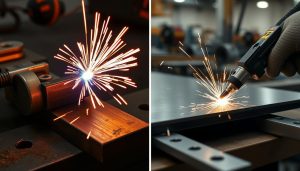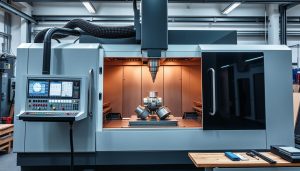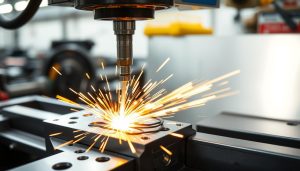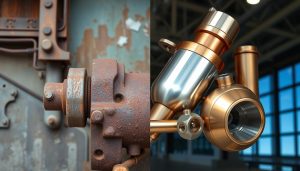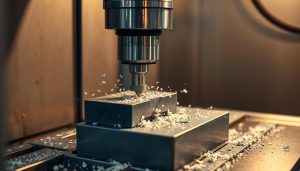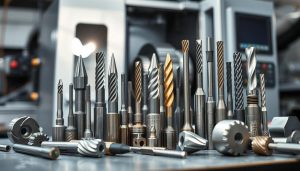In modern manufacturing, choosing between horizontal and vertical milling matters a lot. It affects how efficient, precise, and successful a project can be. Knowing the key differences between these methods is key for businesses and individuals looking to improve their metalworking.
What really makes them different, and how do you pick the right one for your needs? Let’s look into the details of horizontal and vertical milling. This will help you make smart choices that lead to great outcomes. So, let’s explore the world of milling, where choosing between horizontal and vertical can be crucial.
What is Horizontal Milling?
Horizontal milling is a way to remove material from a workpiece. It uses a spindle that spins horizontally. This setup makes it easy to remove material and position the workpiece in many ways.
Overview of the Horizontal Milling Process
The machine has a horizontal spindle that meets the workpiece at a right angle. The workpiece sits on a table that moves in different directions. This lets you control it precisely during milling.
The tools, like end mills, spin on the spindle. They cut away material from the workpiece.
Benefits of Horizontal Milling
- Improved chip evacuation: The horizontal setup helps remove chips well. This reduces the chance of material sticking and gives a smoother finish.
- Ability to handle heavier workpieces: The machine can hold bigger and heavier parts. This makes it great for many industrial tasks.
- Versatile workpiece positioning: The table can move in many ways. This lets you position the workpiece for complex tasks.
Common Applications for Horizontal Milling
Horizontal milling machines are used in many fields. These include the automotive, aerospace, and heavy machinery industries. They’re good for making big parts, detailed profiles, and complex shapes.
The machine’s design and the table’s movement make it perfect for precise and efficient work.
| Industry | Application |
|---|---|
| Automotive | Machining engine blocks, cylinder heads, and transmission components |
| Aerospace | Producing aircraft parts, such as wing ribs and fuselage frames |
| Heavy Machinery | Manufacturing large machine frames, gearboxes, and structural components |
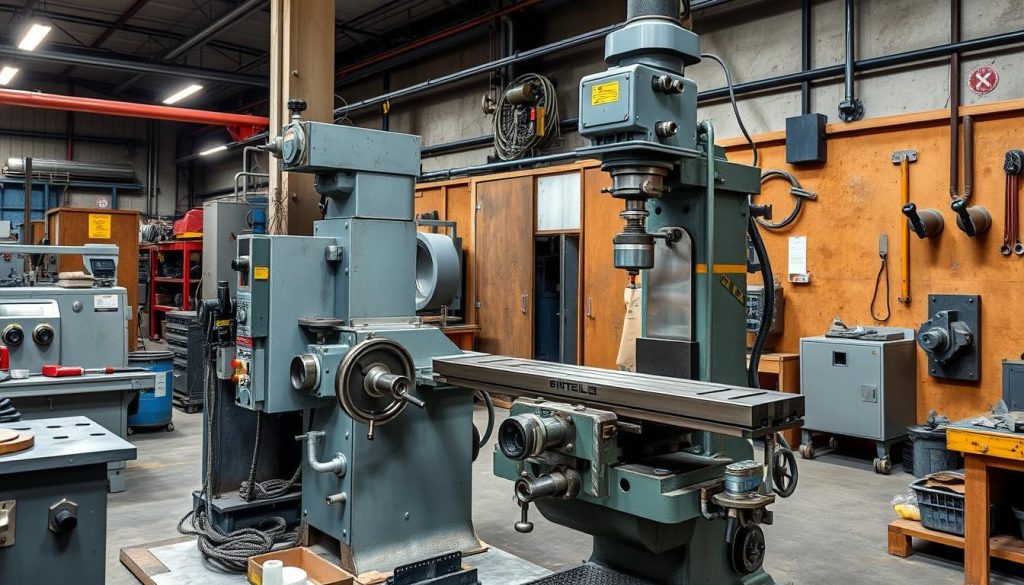
What is Vertical Milling?
Vertical milling is a common machining method. It uses a vertical milling machine to cut away material from a workpiece. Unlike horizontal milling, where the spindle is horizontal, the spindle in vertical milling is vertical. This allows for a unique approach to cutting.
Overview of the Vertical Milling Process
In vertical milling, the workpiece is held on a table that moves in the X and Y axes. The spindle, which holds the end mills or face milling cutters, moves along the Z-axis. This setup lets the machine make many shapes and features, like pockets, slots, and complex contours.
Advantages of Vertical Milling
- Increased versatility: Vertical milling machines can handle a wider range of workpiece sizes and shapes than horizontal milling machines.
- Improved visibility and accessibility: The vertical spindle design makes it easier to see and adjust the cutting process.
- Enhanced chip control: The spindle’s downward orientation helps manage chip flow and debris, improving milling efficiency.
Typical Uses for Vertical Milling
Vertical milling machines are used in many industries, like tool and die making, aerospace, automotive, and general machining. They’re great for milling complex shapes, creating intricate features, and working with smaller parts that need precise control and positioning.
“Vertical milling machines offer unparalleled versatility and precision, making them an essential tool in modern manufacturing.”
Key Differences Between Horizontal and Vertical Milling
When it comes to CNC milling, picking between horizontal and vertical milling machines matters a lot. It affects how efficient, precise, and cost-effective your manufacturing process is. Let’s look at the main differences between these two milling methods.
Tool Design and Orientation
Horizontal milling machines have a spindle that runs horizontally. This lets the cutting tools move side to side across the workpiece. On the other hand, vertical milling machines have a spindle that runs vertically. This setup lets the cutting tools move up and down, straight across the workpiece.
This difference in how the tools are set up changes what tools you can use. It also changes what you can do with each milling method.
Material Removal Rate and Efficiency
Horizontal milling is usually faster and more efficient at removing material than vertical milling. This is because the horizontal setup lets you use bigger, more powerful tools. These tools can take off material quicker and more efficiently.
But, vertical milling is better for detailed or delicate work. It’s great for tasks where you need a lot of precision and control.
Versatility and Cost Comparison
Vertical milling machines are more versatile. They can handle a wider range of workpiece sizes and shapes. This includes smaller or more complex parts. Horizontal milling might be cheaper for big production runs or larger parts.
The choice between horizontal and vertical milling depends on your project’s needs. This includes the material, how precise you need it, and how much you’re making.
| Feature | Horizontal Milling | Vertical Milling |
|---|---|---|
| Milling Efficiency | Higher | Lower |
| Cutting Tools | Larger and more powerful | Smaller and more precise |
| Machine Setup | Better suited for high-volume production | More versatile for complex or delicate parts |
| Cost | Generally more cost-effective | May be more expensive for certain applications |
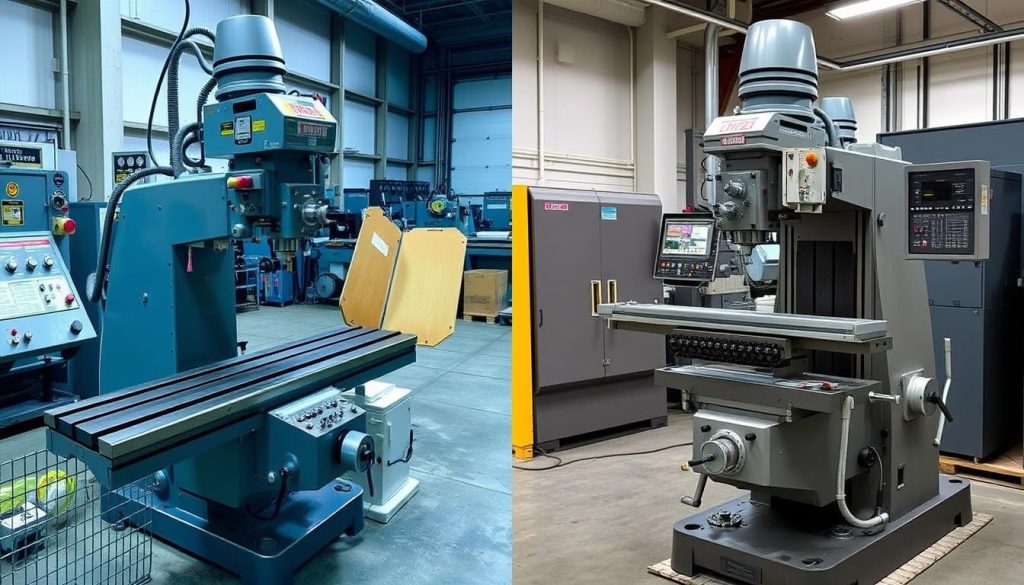
“Choosing the right milling method is crucial for optimizing your manufacturing process and achieving the best possible results.”
Choosing the Right Milling Method for Your Project
Choosing the right milling method is crucial for your project’s success. It matters whether you’re making intricate parts or producing lots of them. Knowing what to consider can help you get the best results.
Material, Precision, and Volume
First, look at your workpiece’s characteristics. Material choice is key because different materials need different methods. For example, soft materials like aluminum work well with vertical milling. Harder materials, like steel, are better with horizontal milling.
Next, think about the precision you need. Vertical milling is great for accuracy and smooth finishes, perfect for precise parts. Horizontal milling is better for parts needing less precision but more speed in production.
Lastly, consider the production volume. For lots of parts, horizontal milling is faster and more efficient. But for fewer parts, vertical milling’s precision and flexibility are more important.
| Factors | Horizontal Milling | Vertical Milling |
|---|---|---|
| Material | Suitable for harder materials like steel | Suitable for softer materials like aluminum |
| Precision | Suitable for parts requiring less stringent tolerances | Suitable for high-precision components |
| Production Volume | Efficient for high-volume production | Suitable for low-to-medium volume runs |
By thinking about these factors, you can choose the best milling method for your project. This ensures you meet your milling selection criteria, manufacturing requirements, and production efficiency needs.
Shixinproto’s Milling Services
At Shixinproto, we’re proud of our skills in both horizontal and vertical milling. We offer precision solutions that meet our clients’ specific needs. Our advanced CNC machining and latest technology, combined with our dedicated team, make us the top choice for milling services.
Expert Solutions for Horizontal and Vertical Milling
Shixinproto’s skilled engineers can handle any milling task with great accuracy and speed. We work on everything from complex aerospace parts to precise automotive components. Our top-notch facilities and equipment guarantee high-quality work on every project. Need precision milling services, custom machining, or rapid prototyping? Shixinproto is here for you.
Why Shixinproto is the Right Choice for Your Milling Needs
Choosing the right manufacturing partner is crucial for your project’s success. At Shixinproto, we’re dedicated to delivering top-notch custom machining and rapid prototyping. Our advanced equipment and team’s deep knowledge let us solve complex milling challenges efficiently. This makes us the perfect choice for your milling needs.
